The other side of Mt. Kolts doesn’t offer many points of interest to choose from. Two or three hours in, FFVI is still very much in “linear” mode as the story’s premise continues to unfold.
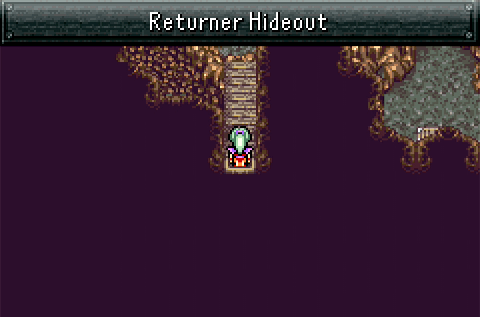
The only point you can travel to here is the Returner hideout — which, if we’re still going with the Star Wars parallels for this one (and we should be!), is basically Yavin IV.

You have one task here, which is presented in fairly explicit terms by the Returners hanging out and blocking passages: Talk to a guy named Banon. You can wander around a little before doing so, but the base is small and mostly obstructed, and there’s nowhere else to go here but to Banon’s office.
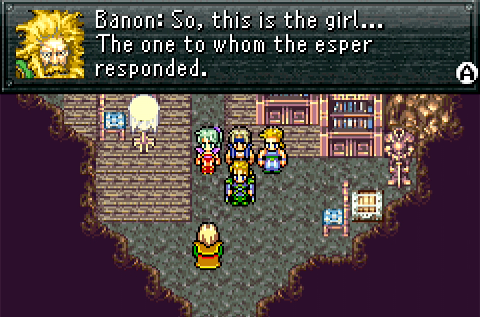
Banon is a wild-haired old man who relays a healthy amount of exposition despite his unkempt appearance. His monologue brings all the disparate plot elements we’ve seen so far together into a single nexus of party objectives: The Empire is awful and mean, the Returners aren’t particularly happy about that fact, and they hope to capitalize on Terra’s inexplicable resonance with the creature in the ice caverns — an “Esper” — to give themselves a leg up on the bad guys.
Terra (and thus the player) is given a choice of whether or not to help the Returners’ cause.

The characters give this “choice” some nice lip service, admitting that forcing Terra’s compliance would make them as crappy as the Empire, but in practice it all works out the same. You the player can’t advance the game or go anywhere beyond the ground you’ve already covered unless you commit to the Returners; until you join the cause, all you can do is wander sadly through the world as a lonely Terra. While it might be interesting if you could make an active choice here and potentially march off to join the Imperial cause, that’s not really how Final Fantasy rolls. (Or should I say, “roles”? No, never mind.)
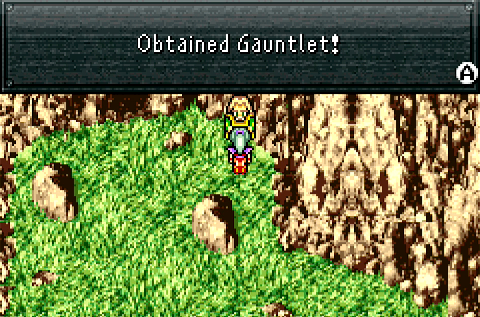
That being said, your decision here does count for something. Banon gives you a gift — a Relic — once you join his team. If you say “no” several times before acceding to the cause, you’ll receive a precious Genji Glove, which lets you dual-wield single-handed weapons. Sadly, I didn’t say “no” enough and only received the lesser reward, a Gauntlet, which does the opposite: It allows you to wield a single weapon in both hands for extra strength. But that’s OK, too: If you give a character a Gauntlet and a Knight’s Code, they essentially become a classic Final Fantasy Knight-class warrior. As I mentioned before, Relics represent about one-half of the game’s Job System substitute.
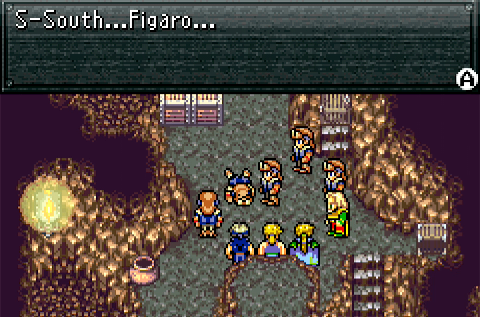
Whatever choice you make, narrative convenience asserts itself and this messenger collapses in the Returner hideout to announce that South Figaro has fallen to the Empire. Almost as though the city had a traitor in its midst. If only someone had caught wise to their plan….
At this point, the party divides up: Terra, Banon, and Edgar head back to Narshe to meet with the Returners there and hang out with the Esper, while Locke scurries off to run interference in South Figaro and hinder the Empire’s inevitable assault on Figaro Castle (and Narshe). This has the side effect of Locke leaving the party, which incidentally opens up a slot for a new companion to join…

Locke leaves the scene, and the game continues to follow Terra’s tale, further cementing the idea that she’s the main character of the piece. The party now consists of her, Edgar, Sabin, and new arrival Banon. You’ll notice that there was no rename prompt for Banon; he’s in the party, but he’s not a true member, taking part only in this portion of the game.
Before we discuss Banon, though, it’s worth looking at Sabin’s Blitz skill, to which we were so indelicately introduced at the end of the Mt. Kolts excursion. While Sabin’s Monk class is the first “standard” Final Fantasy character class we’ve seen in FFVI, his actual skill set is a decidedly unconventional take on the role. The Monks we’ve seen in previous games were defined by their raw physical power and inability to equip heavy armor or traditional weapons, which is largely true of Sabin as well. His weapon choices are largely limited to the Claws Yang used in FFIV… though unlike Yang’s Claws, Sabin’s tend to add to his attack power rather than simply adding an elemental or status modifier to his attacks.
But Blitz bears very little resemblance to Monk skills of yore. In previous games, the class’ special traits consisted of passive modifiers and buffs: The ability to double attack power at the expense of defense or vice versa, or simply stat modifiers that boosted that character’s health. Blitz’s, however, mostly consist of various special attacks, largely directed at single targets.
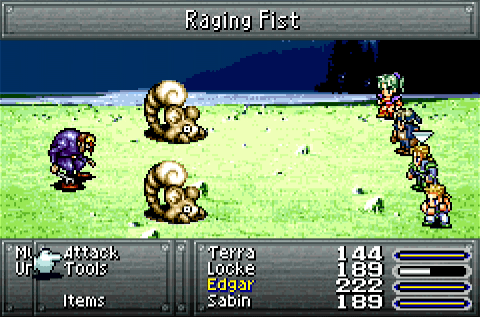
Raging Fist, for instance, allows Sabin to launch a vicious physical attack against a single foe. Aura Cannon lets you blast a single foe with a holy-element beam. Rising Phoenix hits the entire enemy party with a fire-based attack. All handy, but the only skill in the entire Blitz repertoire similar to those of FFV‘s Monk class is Chakra, which raises another party member’s HP to whatever Sabin’s current HP is. While powerful and free (in terms of mana cost), Sabin’s Blitzes have downsides; many of them are based not on his physical power but rather his spirit (magic) stat, which is terrible by default. Many of them hit only a single target, and in most cases this target is selected at random. That makes some skills practically useless in certain situations; for example, Meteor Strike doesn’t have any effect against certain foes (e.g. flying enemies), and there’s a chance the game could randomly select a null target like that if one is present in a battle.
The biggest drawback has to do with the way Blitzes are input, though. As discussed last time, you execute these actions by punching in memorized sequences of controller commands, similar to fighting game commands. It’s a clever little addition, given the nature of Sabin’s skills (Aura Cannon is essentially a Hadouken and the input is exactly the same), but it doesn’t feel very Final Fantasy-ish. The game can also be rather persnickety about timing these inputs, which can lead to this error message:

…at the worst possible times. A fumbled input equals a wasted turn for Sabin.
On the other hand, while Sabin’s skills don’t seem to have much to do with the Monk class as it existed before FFVI, he became the template for other Monk-type characters in subsequent games. Tifa, Zell, Amarant, and especially the Monk class in Tactics all use skills patterned around Sabin’s. So there’s that! Still, despite being a fairly amazing character at this early stage in the game, you really have to custom-build Sabin to make him a long-term contender… and given that he’s one of three mandatory characters in the end game, it’s important to understand how the advanced game systems work to maximize his potential. Something the game doesn’t go out of its way to explain, unfortunately.
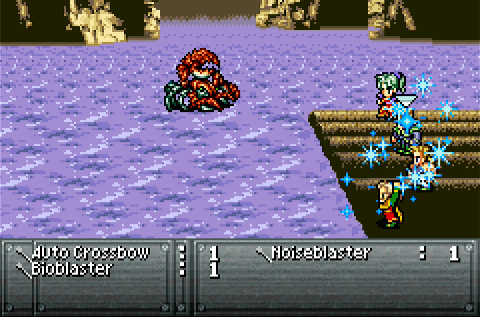
Banon, on the other hand, is much easier to explain. His class is listed as Oracle, but his powers don’t really resemble the strange abilities that Oracles in FFV Advance or Tactics command. Since he only appears in this brief sequence on the Lete River and shortly after, his skill set consists of a single ability: Healing the entire party for free. Why have Terra waste her magic points on Cure when Banon can recover the entire party for more HP without cost?
And there’s really no reason not to have Banon use his healing skill on every turn. His physical power is laughable, and more to the point, you’re given a key condition for this raft ride at the very beginning: If Banon dies, it’s game over.

And since he’s super weak, it doesn’t take much to do him in. Of course, if you paid attention to how row positioning works, you can move him to the back to cut the physical damage he takes in half. This also halves the physical damage he deals, but since he’s basically your healbot, that shouldn’t matter.

It might be worth mentioning how Game Overs work in FFVI, because loss is handled differently here than in any other Final Fantasy: Namely, there’s no such thing as a Game Over. If your party falls, or you fail to meet a victory condition, you hear a sad little tune and your party leader collapses despondently… and then immediately respawns at the last save point, with all experience you’ve earned since that save point intact.
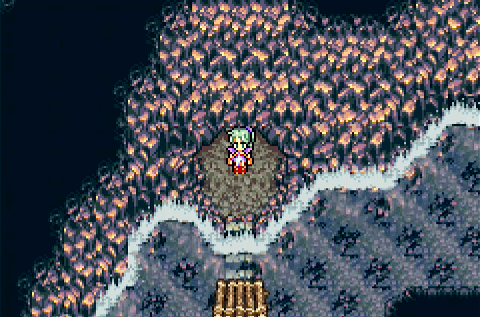
This is more a Dragon Quest approach than Final Fantasy but is even more generous than in DQ games, since you don’t lose half your gold for dying. It’s not a bad design choice, but it’s very unconventional in a Final Fantasy game.

As for the Lete River itself, this entire sequence is the first of several in the game where you have no control over your progress. Your team drifts down the river on the current, encountering random battles as usual but otherwise helpless to act (you can’t even access the menu screen while on the raft). Your only chances for interaction come at a handful of forks with decision points that allow you to pick the direction you’ll advance. Generally, one direction takes you forward, while the other sends you back up the river in a loop (which some people exploit to grind for gold and experience).
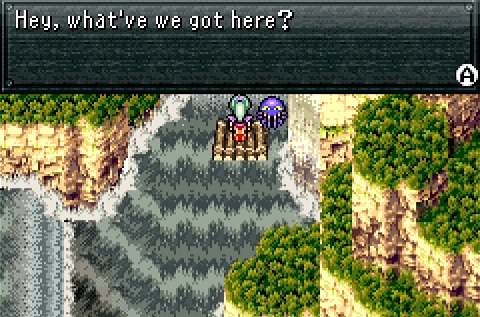
Eventually, you’ll make it far enough downstream to engage the interest of the game’s most memorable recurring boss, a weird octopus named Ultros.
While this fight works as you might expect, Ultros is considerably more powerful than previous bosses. He uses primarily physical attacks, generally hitting the entire party at once for moderate damage — something Banon can easily negate by using his Pray command.
However, he’ll occasionally turn his attention to a specific party member for a focused attack, which almost always hits hard enough to knock that character out of action. You can cheat this by putting the entire party in the back row and using only secondary commands (most of which ignore row modifiers), but even if you play it straight the game still gives you a fighting chance.
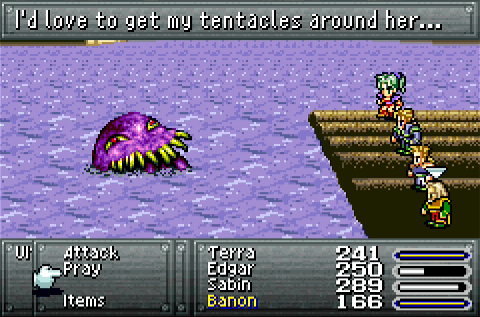
Ultros betrays his intentions with his combat banter, giving a hint of which character he’s about to target. You can act quickly and set this character to defend, which will minimize the damage they take from a single attack.
Also, it’s here we learn that Ultros is a gross pervert.
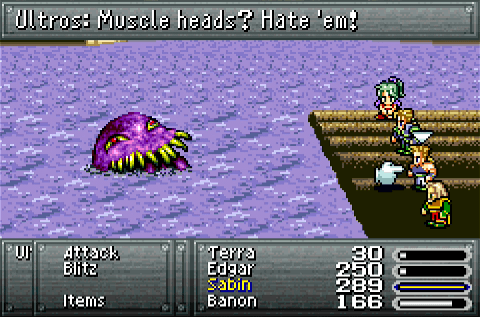

This is the message you really don’t want to see, since it means Banon is the next target. And even if you have Phoenix Down with which to revive him, the instant his HP hits zero you lose the fight.

His chattiness also betrays a certain weakness to fire: If Terra casts Fire on him, he responds with indignation and counterattacks. However, his counter is to squirt ink, which does light damage and potentially inflicts Blind status on Terra. But since spell accuracy isn’t affected by Blind, this doesn’t actually matter. You can keep hitting him with Fire to end the fight rather promptly.
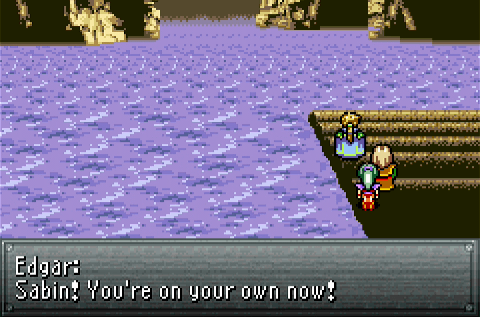
You don’t really win, however. Ultros simply bails on the fight when he realizes he’s in trouble, and Sabin jumps in after him, only to be flung to parts unknown. Edgar, ever the loving brother, shrugs and heads along the river with the remaining party.
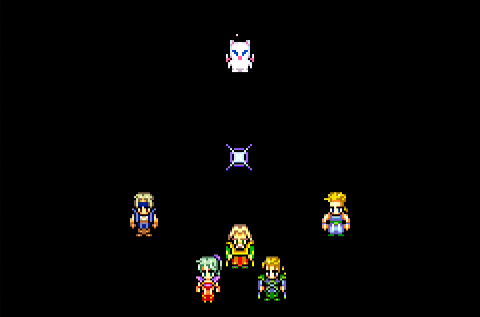
All of this has been a contrivance to introduce the next game mechanic: The split scenario system. Once again, you have multiple parties to control, but this time it doesn’t work like it did in the battle of the caves at Narshe. You can’t swap between parties here. Instead, you use Mog to pick a party, whose scenario you follow to its conclusion. In previous Final Fantasy games, the secondary scenarios probably would have simply played out in a cut scene, but here you’re given control over both each party and the order in which you experience their tale — adding a neat bit of player agency to what ultimately is an arbitrary narrative direction.
It just dawned on me that since rivers don’t rise up hills in real life, the Lete River’s loops make it the aquatic equivalent of MC Escher’s never ending stairs. Someone should do a fan drawing to make the similarity obvious.
I’d also mention that the Blind status does absolutely nothing in the SNES version of the game due to a bug. (This was fixed in the GBA version.) You’re probably going to mention that later on, I’d wager.
I dunno, probably not. One of the reasons I picked the GBA version is because it works the way the game was meant to.